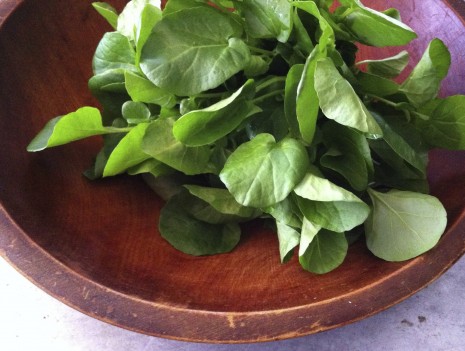WATERCRESS FOR SPRING
Every April, my mother and I would spend hours in the woods, wading in bone-chilling mountain streams to pick watercress before it flowered and disappeared until the following spring. Somewhere, my mother had picked up the knowledge that the plant had been used as both food and medicine in ancient times, and each year, I’d be treated to a homily on how brilliant the Greeks were and how miraculous watercress was while we teetered on rocks, midstream. I recall that Mom seemed just as invested in the plots of the Walter Farley books I was enthralled by at the time, and connected the dots with an unexpected present: Xenophon’s Art of Horsemanship. I have it still. Apart from the sentimental attachment, it’s still as relevant as it was when it was written, more than 2,300 years ago.
For a few weeks, before dinner we might be treated to watercress soup served in my grandmother’s thinnest porcelain cups, but mostly we enjoyed the watercress fresh and pungent in salads, with a very light dressing. It was nothing more than a sprinkling of salt and lemon juice, with a final benediction of olive oil—back then, not all that easy to find down South, and, consequently, one of my mother’s most valued condiments.
These days, I tend to avoid the wild stuff unless I know for sure it comes from a very pure stream; in fact, I’ll go so far to say that those people who forage on the outskirts of golf courses are crazy. The (organic) cultivated watercress above is from the grocery store. It was so beautiful, I just had to pounce. In flavor, it isn’t as characterful as the wild green, but it wilts nicely under a juicy steak or roast chicken and adds pep to sandwiches. Because I bought heaps, there will be enough left for a gingery stir-fry, garlic-studded sauté, or that salad. To my mind, it will still taste exactly the same, even though my salt and olive oil are much fancier than any my mother knew.
She was absolutely right, of course, about the healthful properties of watercress. It’s a member of the Brassica family (like those nutritional overachievers broccoli, brussels sprouts, and kale) and one cup of the sprigs contains more than enough vitamin K to get you through the day, as well as vitamins, A, C, E, and B6; in the mineral department, you’ll find phosphorus, magnesium, and calcium. Ounce for ounce, it is richer in antioxidants than apples or broccoli.
Not that it matters, when you find yourself in the wrong place at the wrong time—Monday morning in Boston, for instance.
Perhaps that’s why all I want right now is watercress—such a strong-willed green, it’s something you can brace your back against. Even when served in the thinnest porcelain cups.
Posted: April 16th, 2013 under cooking, people + places, spring.


